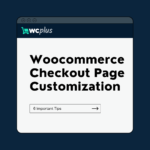Increasing sales and keeping customers happy are your top priorities as a store owner. Optimizing your checkout process is one of the most crucial steps in achieving these goals. A smooth, efficient checkout can mean the difference between a completed sale and an abandoned cart. This is where checkout optimization comes into play.
The checkout process is the final hurdle in the shopping journey, and it’s where many potential customers drop off. These obstacles can deter even the most determined shoppers, Whether due to complicated form fields, limited payment options, or unexpected shipping costs. By refining your WooCommerce checkout, you can help your customers easily complete their purchases, boosting your conversion rates and overall customer satisfaction.
In this post, we’ll explore some practical tips and strategies to enhance your WooCommerce checkout, ensuring a seamless shopping experience for your customers.
What is Checkout Optimization?
Checkout optimization is all about making the checkout process on your ecommerce site as smooth and efficient as possible. This involves a series of strategies to reduce friction and make it easier for customers to complete their purchases. When the checkout process is seamless and easy to navigate, converting customers and encouraging repeat purchases is far simpler.
But checkout optimization goes beyond just the checkout page. Cart abandonment can be caused by moments of friction throughout the entire shopping journey, not just at the end. This means the best checkout optimization strategy starts when a shopper enters your website, ensuring a smooth and enjoyable user experience from start to finish.
Several factors can be optimized as part of the checkout process. One key area to focus on is the layout and design of the checkout screen. A clean and uncluttered design helps guide customers through the checkout process. For example, using WC Plus’ progress bar can show customers how many steps are left, reducing anxiety and uncertainty. Another important factor is the number of form fields. Reducing the number of form fields can significantly improve the checkout experience. Only ask for essential information to streamline the process. For instance, a single “full name” field might be sufficient instead of separate fields for first name and last name.
Multiple payment options such as credit cards, PayPal, and mobile payment methods can cater to customer preferences. This flexibility can reduce cart abandonment rates. For example, allowing customers to pay via Apple Pay or Google Wallet can make the checkout process quicker on mobile devices. Providing clear information about shipping costs and offering free shipping incentives can encourage customers to complete their purchases. For instance, “Free shipping on orders over $50” can be a compelling motivator. Additionally, communicating delivery times to manage customer expectations is crucial. Displaying a message like “Order within the next 2 hours for delivery by Friday” can create a sense of urgency and reliability.
Allowing customers to complete their purchases without creating an account can reduce friction. Guest checkout options can be particularly appealing to first-time shoppers who don’t want to commit to creating an account. Incorporating security badges and customer reviews can reassure customers about the safety and reliability of their purchases. Displaying trust signals like SSL certificates or badges from well-known security companies can enhance customer confidence. Using exit intent popups to offer discounts or remind customers of items left in their cart can help reduce cart abandonment. For instance, an exit intent popup offering “10% off if you complete your purchase now” can incentivize customers to stay and complete their transactions.
Checkout optimization is all about refining the design and functionality of the checkout process in an e-commerce store. The goal is to make it easier and more convenient for customers to complete their purchases, reducing cart abandonment rates and increasing customer satisfaction.
Why Checkout Optimization is Crucial for Your Online Store
Checkout optimization is crucial for any ecommerce business aiming to maximize conversions and enhance the overall customer experience. The checkout process is the final step in the customer journey, where potential buyers become paying customers. It’s a critical moment that can make or break a sale. If the checkout process is cumbersome, confusing, or lengthy, it can lead to cart abandonment, resulting in lost revenue for the business.
Reducing Cart Abandonment
It’s a known fact that cart abandonment hurts a brand’s bottom line. However, the reasons behind cart abandonment are often misunderstood. Shoppers who place items in their carts and then abandon them aren’t disinterested in your brand. They’re showing a strong intent to buy. The problem is that something got in the way of them completing their purchase.
A clunky checkout process is one of the main culprits. By optimizing your checkout, your brand stands to recover a lot of money in lost revenue. For instance, simplifying the checkout flow by reducing the number of form fields and steps can make a huge difference. Studies have shown that each additional step in the checkout process can decrease conversion rates by up to 35%. Features like guest checkout and pre-filled form fields can streamline the process, making it easier for customers to complete their purchases without unnecessary hassle.
Increasing Customer Retention
Cart abandonment is just one element of online store visits going underutilized in ecommerce. It’s not enough to secure that first purchase from a customer; you also need them to shop with you again if you’re going to build a healthy business. It’s important to remember that your customer’s final impression of the shopping experience determines whether they’ll return to your brand. They might have completed a purchase, but if they had to fight tooth and nail through a complex checkout experience, they’re unlikely to buy from you again.
Checkout optimization is directly linked to your customer retention efforts. To foster repeat purchasing behavior, you need to give customers a positive checkout experience. This includes offering multiple payment options like credit cards, PayPal, and mobile payment methods, which cater to different preferences and make the checkout process smoother. Additionally, providing clear information on shipping costs and offering incentives like free shipping can enhance the customer experience, making them more likely to return.
Enhancing Customer Satisfaction
A seamless checkout process boosts conversion rates and enhances overall customer satisfaction. Customers who have a smooth and hassle-free checkout experience are more likely to feel positive about your brand. This positive experience can lead to increased customer loyalty and higher chances of repeat purchases. Implementing trust signals, such as security badges and customer reviews, can further reassure customers about the safety and reliability of their purchase, contributing to a better shopping experience.
Boosting Conversion Rates
Investing the time to optimize the checkout process can pay off both in the short and long term. Businesses can see a significant boost in their conversion rates by reducing cart abandonment rates and increasing successful transactions. Features like exit intent popups offering discounts or reminders about items left in the cart can also help to reduce cart abandonment and encourage customers to complete their purchases. For example, an exit intent popup offering “10% off if you complete your purchase now” can incentivize customers to stay and finish their transaction, increasing conversion rates.
In general, optimizing the checkout process can have a significant impact on conversion rates and overall business performance. A study published in the Journal of Marketing found that reducing the number of steps in the checkout process can increase conversion rates. We’ve found that across all industries, 70% of checkouts are abandoned due to various factors, with shipping costs and speed of shipping being the top reasons. By addressing these issues through checkout optimization, ecommerce businesses can enhance their performance and drive more sales.
Common Hiccups in the Checkout Process
Not Making the Guest Checkout Option More Prominent
One of the most frequent stumbling blocks in the checkout process is the lack of emphasis on the guest checkout option. Many ecommerce platforms default to prompting users to create an account before completing a purchase. However, this can deter potential buyers, particularly those seeking a quick and hassle-free transaction.
For instance, when examining Zara’s checkout process, we find that it mandates account creation for every purchase, lacking a guest checkout option. This approach might discourage customers looking for a seamless checkout experience, potentially leading to lost sales.
Asking for Too Much Information
Another prevalent issue is the tendency to request excessive customer information during checkout. Studies indicate that customers are often reluctant to share certain personal details, such as phone numbers, especially when the necessity for such information is unclear.
Many customers hesitate to provide their phone numbers during checkout, particularly when the purpose behind the request is ambiguous. This lack of transparency regarding data collection can foster suspicion and result in abandoned carts.
Not Putting Mobile First
Given the popularity of mobile devices in online shopping, failure to prioritize mobile optimization can prove detrimental to ecommerce businesses. Many platforms neglect to tailor the checkout experience to mobile users, resulting in subpar experiences on smaller screens.
Issues like unresponsive design and cumbersome forms can frustrate mobile users, leading to abandoned carts and lost sales. Emphasizing mobile-friendly design ensures a seamless experience across devices, thereby improving conversion rates and customer satisfaction.
Not Applying Auto-Format Spaces to the Credit Card Number Field
The absence of auto-formatting in credit card fields can introduce friction during checkout. Customers may struggle to enter their details accurately without automatic spacing, increasing the likelihood of errors and validation issues.
Implementing input masks that automatically format credit card numbers streamlines the checkout process, enhancing user experience and reducing cart abandonment rates. This optimization is critical for ensuring a smooth and efficient checkout process, ultimately driving higher conversion rates and customer satisfaction.
Pro Tips for Streamlining Your Checkout
Analyzing User Behavior Throughout the Checkout Process
Understanding how customers interact with your checkout process is crucial for identifying friction points and improvement opportunities. Start by utilizing tools like heatmaps and session recordings to track user behavior on your checkout page. Heatmaps can reveal where users click, pause, or drop off, while session recordings provide a detailed view of the customer journey. Pay particular attention to form fields that receive multiple interactions or corrections, as these can indicate areas of confusion or frustration.
Additionally, use analytics tools such as Google Analytics to monitor drop-off rates at each stage of the checkout funnel. Look for patterns correlating with higher abandonment rates and focus on these critical areas to enhance the user experience. By leveraging these insights, you can make data-driven decisions to streamline your checkout process, ultimately boosting conversion rates.
Simplifying the Checkout Form Fields
One of the most effective ways to streamline your checkout process is by simplifying the form fields. Minimize the number of required fields to reduce user input and save time. Use autofill and predictive text features to expedite the form completion process. These tools can automatically populate user information, making the process faster and more convenient. Ensure that each form field is clearly labeled and easy to understand, helping to prevent errors and confusion.
Additionally, consider implementing a progress indicator with WC Plus to show users how many steps remain in the checkout process. This can help reduce anxiety and improve the overall user experience. By making these changes, you can create a smoother and more efficient checkout process that encourages customers to complete their purchases.
Offering Guest Checkout Options
Providing a guest checkout option can significantly reduce friction for first-time customers. Many users may hesitate to create an account due to privacy concerns or the perceived time commitment. Allowing customers to checkout as guests eliminates these barriers and makes the process quicker and more convenient. Streamline the guest checkout process by removing unnecessary steps and focusing on essential information only.
Emphasize the benefits of guest checkout, such as faster transactions and increased user convenience, to encourage users to take advantage of this option. Additionally, you can use WC Plus to create an account after the purchase is complete, making it easy for satisfied customers to register for future purchases. By offering a seamless guest checkout experience, you can enhance customer satisfaction and reduce cart abandonment rates.
Integrating Multiple Payment Gateways for Flexibility
Incorporating multiple payment gateways into your checkout process can cater to diverse customer preferences and increase the likelihood of completing a sale. Popular payment options like PayPal, Apple Pay, and Google Pay allow customers to choose their preferred method. Display recognizable payment icons to instill trust and credibility.
WC Plus ensures seamless integration and compatibility with various payment methods to provide a frictionless checkout experience. Additionally, consider supporting local payment options if you operate in international markets. By offering a variety of payment methods, you can accommodate different customer needs and preferences, ultimately enhancing the user experience and boosting conversion rates.
Incorporating Address Autocomplete for Ease of Data Entry
Implementing address autocomplete functionality can significantly simplify shipping and billing information input. WC Plus uses tools like Google Places API or address verification services to provide accurate address suggestions based on user input. This speeds up the checkout process and reduces the likelihood of errors.
Autocomplete features can help users quickly fill out their information, reducing friction and improving the overall user experience. Additionally, address verification services can ensure that the provided addresses are valid and deliverable, minimizing issues with order fulfillment. Incorporating address autocomplete can streamline the checkout process, reduce errors, and enhance customer satisfaction.
Leveraging Personalization and Customization Techniques
Personalization can play a significant role in optimizing the checkout process and increasing customer engagement. Offer returning customers the option to save their payment information securely for future purchases. This allows for a faster and more convenient checkout process, encouraging repeat business.
Additionally, WC Plus implements product recommendation tools to suggest relevant items during checkout. These recommendations can be based on past purchase history and browsing behavior, increasing the likelihood of cross-selling and upselling. Tailor the checkout flow based on user preferences, such as preferred delivery options or payment methods, to create a more personalized and engaging experience. By leveraging personalization and customization techniques, you can enhance the user experience, increase customer loyalty, and drive higher conversion rates.
Ensuring Mobile-Friendly Checkout Experience
With the growing number of mobile shoppers, providing a seamless mobile checkout experience is essential. Design responsive checkout pages that adapt to various screen sizes and resolutions. Prioritize mobile-friendly elements like large, tappable buttons and optimized form fields for touchscreen input. Minimize load times by optimizing images, scripts, and content to ensure a fast and efficient mobile checkout process. Utilize caching mechanisms and content delivery networks to deliver pages swiftly. Additionally, integrate mobile-specific features like Apple Pay, Google Pay, or Samsung Pay to offer convenient and secure checkout options
By implementing these pro tips for streamlining your checkout process, you can create a seamless and efficient experience that enhances customer satisfaction and drives conversions. For more insights on enhancing online checkout processes, refer to Amazon’s checkout optimization strategies.
Conclusion
Mastering efficient checkout optimization strategies is important to staying ahead of the competition and providing a seamless shopping experience for customers. By committing to a customer-centric approach and improving continuously, businesses can transform their checkout process into a competitive advantage and drive sustainable growth.
Overall, there are several levers you can pull when it comes to checkout optimization. The possibilities are endless, from inputting ‘arrives by’ dates on each delivery option to finding your optimal free shipping threshold, setting unique rules for shipping incentives, launching automation to streamline the process for your customers, and diversifying your carrier mix. Many brands just don’t know these options exist yet.
That’s why we’re here. Get started with WC Plus plugin to get started with optimizing your checkout process and give your customers the best checkout experience.







